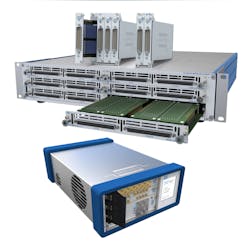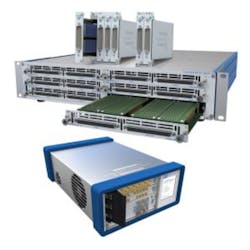Pickering Interfaces to highlight PXI and LXI switching at ITC
Clacton-on- Sea, UK. Pickering Interfaces announced it will highlight its latest high-density PXI and Ethernet LXI switching and simulation solutions at the International Test Conference (ITC) 2017 October 31-November 2 in Fort Worth, TX.
High-density scalable LXI Ethernet reed-relay matrix solution (Model 60-2xx). Originally designed to test semiconductors at wafer and package levels, this reed-relay matrix solution combines an LXI chassis with new plug-in matrices. The range comprises four models covering matrices of up to 1,536 x 4 in increments of 128, 768 x 8 in increments of 64, 384 x 16 in increments of 32, and 192 x 32 in increments of 32.
Users can specify as many or as few plug-ins (up to six) as required and can field-upgrade the chassis to extend the matrix when necessary. More than 1,500 relays can be closed simultaneously for specific conditions for parametric testing. These plug-ins also offer built-in scan list sequence stores with triggering capability, providing users with the ability to set a series of up to 200,000 pre-determined sequences on a LXI instrument; the sequences can be triggered by software or one of the sixteen DIO software configurable open collector triggers. They also feature multibus capability for parallel testing.
BRIC ultrahigh-density PXI matrix modules (Model 40-559). These PXI matrices are robust 1-A/20-W switching modules, with up to 4,096 crosspoints. Constructed with Pickering Electronics’ new miniature 4-mm x 4-mm reed relays, these new 1-A matrices have similar switch densities compared to 0.25-A, 0.3-A, or 0.5-A high-density matrix solutions on the market, providing a more robust and reliable switching in the same footprint. The matrices are available in 2-, 4-, or 8-slot PXI sizes and are designed for high-performance matrix requirements. With their high level of switching density, these PXI matrices allow a complete functional ATE system to be housed in a single 3U PXI chassis and allow the use of lower cost 8- or 14-slot PXI chassis. The 40-559 is available with Y-bus widths of x4, x6, x8, x12, and x16, the three smaller versions having the added versatility of a dual analog bus, which allows each BRIC module to be programmatically configured as two totally separate matrices.
The range comes with Pickering’s Built-in Relay Self-Test (BIRST) and is also supported by the company’s eBIRST switching system test tools. These tools provide a quick and simple way of finding relay failures within the modules.
4-slot USB/LXI modular chassis (Model 60-105). This chassis complements Pickering’s recently released 2-slot USB/LXI modular chassis in that they both offer a small, lightweight form factor suitable for portable, benchtop, and space-restrictive applications. These chassis are designed for desk or rack mounting and feature remote control via USB or LXI Ethernet. Remote control over a network enables the switching function of a test system to be located as close as possible to the target equipment. This new 4-slot chassis supports between one and four Pickering 3U PXI modules. Possible systems include switching matrices up to 2208 crosspoints or up to 72 channels of programmable-resistor/sensor simulation.
Both the 2-slot and this new 4-slot chassis are USB 3.0 compatible and have a fully compliant LXI interface. These communications standards enable the chassis to be controlled directly through standard interfaces found on most personal computers and tablets that support HTML5, allowing for a practical route into a variety of applications in the modular test and measurement market.
Also highlighted will be Pickering’s eBIRST switching system test tools and Switch Path Manager signal-routing software. The eBIRST tools were designed specifically for Pickering’s PXI, PCI, or LXI (Ethernet) products; they simplify switching-system fault-finding by quickly testing the system and graphically identifying the faulty relay. Switch Path Manager signal-routing software streamlines signal routing through switching systems and speeds up the development of switching system software.
Alongside Pickering Interfaces in the booth will be its sister company, Pickering Electronics, which will be showing its range of reed relays, including the new high-density 4-mm x 4-mm series.
About the Author

Rick Nelson
Contributing Editor
Rick is currently Contributing Technical Editor. He was Executive Editor for EE in 2011-2018. Previously he served on several publications, including EDN and Vision Systems Design, and has received awards for signed editorials from the American Society of Business Publication Editors. He began as a design engineer at General Electric and Litton Industries and earned a BSEE degree from Penn State.

